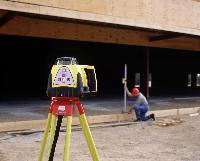Manufacturer of high-quality measuring tools
Rotary laser
Areas of application for rotating lasers outdoors
Pouring foundations, formwork work, measuring buildings, laying terraces, parking lots, depth control for excavation and grading. The range of applications is practically unlimited. In outdoor areas, the visibility of the laser lines is low or non-existent, depending on the lighting conditions. This also applies to green laser diodes, the benefits of which can only be enjoyed indoors. With the help of a suitable laser receiver, the laser lines can be picked up and reproduced. This is done with an optical or acoustic signal, which the laser detector emits when approaching or reaching the exact escape route. With digital laser detectors, it is also possible to display differences to the target height in mm or cm. Together with a machine receiver, the rotation laser is also used to control an excavator bucket or dozer blade. The machine receiver is basically a large laser detector whose display is easy to read even from a distance. While a laser detector is held in the hand or mounted on a measuring stick during measurement, the machine receiver is mounted on the excavator bucket or dozer blade while the operator is sitting in the cab. The machine receiver must therefore be easy to read even from a distance.

Höhen übertragen mit einem Rotationslaser
Foto: Leica Geosystems |
|
![]()
|
|
![]()
|